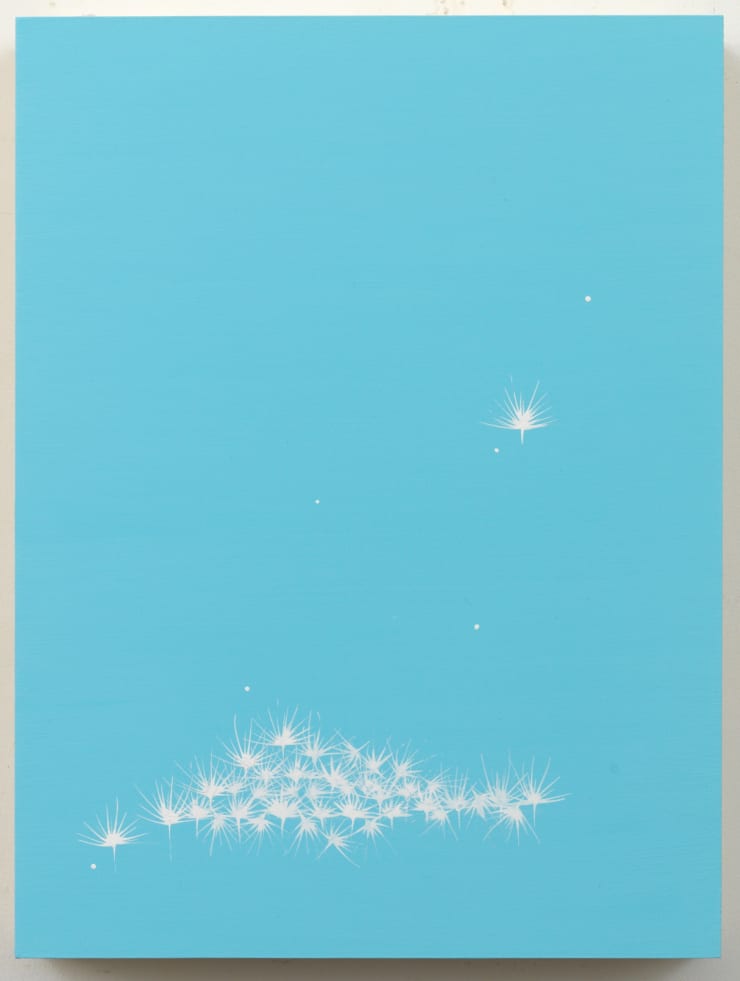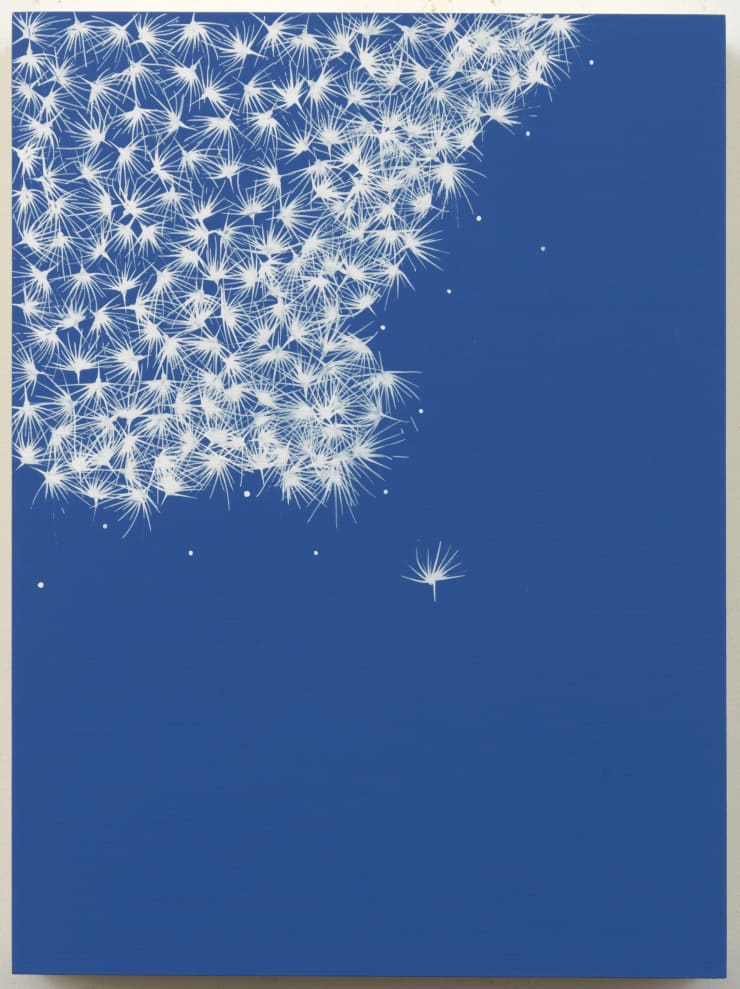-
POURAN JINCHI
FLY LIKE DANDELIONS
-
The Third Line is pleased to announce our fifth solo exhibitions with Pouran Jinchi. Jinchi was inspired to embark on this new body of work, Fly Like Dandelions, after reading an article titled Great Climate Migration in the New York Times. The article tells the story of Jorge A., a Guatemalan farmer forced to flee due to climate change's impact on agriculture. Jinchi's inspiration for this series stems from landscapes affected by climate change, such as ghost forests and arid lands.
-
On Pouran Jinchi’s ‘Fly Like Dandelions’ (2020-2023)
L. Karroum -
 Pouran Jinchi, Fly Like Dandelions 6, 2023, Inks on canvas, 121.92 x 121.92 cm
Pouran Jinchi, Fly Like Dandelions 6, 2023, Inks on canvas, 121.92 x 121.92 cm -
-
 Pouran Jinchi, Fly Like Dandelions 4, 2020, Inks and Gesso on Canvas, 121.92 x 121.92 cm
Pouran Jinchi, Fly Like Dandelions 4, 2020, Inks and Gesso on Canvas, 121.92 x 121.92 cm -
-
"Jinchi describes this combination of traditional calligraphy techniques and abstraction as creating canvases that are “somewhere between perception and reality, truth and meaning”"
Jinchi’s paintings are compositions of fragmented calligraphic strokes that create abstract shapes and markings. This approach was inspired by Jinchi’s formal training in traditional Persian calligraphy in Iran, where she lived as a child and teenager. Later, when developing her painting practice – an organic process taken without formal training – Jinchi returned to calligraphy as the starting point of inspiration. She has continued to approach each painting from the starting point of calligraphic script, creating a unique marriage between the concept of each series, and form. Jinchi describes this combination of traditional calligraphy techniques and abstraction as creating canvases that are “somewhere between perception and reality, truth and meaning”[1]. In this relationship between form and concept, the compositions of miniature creatures seem to represent groups or masses, evoking the movement of displaced humans or animals as they cross the canvas, suggesting their transition between territories or continents.
-
 Pouran Jinchi, Fly Like Dandelions 10, 2023, Inks on canvas, 119.38 x 119.38 cm
Pouran Jinchi, Fly Like Dandelions 10, 2023, Inks on canvas, 119.38 x 119.38 cm -
-
 Pouran Jinchi, Fly Like Dandelions 7, 2023, Inks on canvas, 121.92 x 121.92 cm
Pouran Jinchi, Fly Like Dandelions 7, 2023, Inks on canvas, 121.92 x 121.92 cm -
-
 Pouran Jinchi, Dandelion Clouds 9, 2020 Inks and Gesso on Board, 30.48 x 22.86 cm
Pouran Jinchi, Dandelion Clouds 9, 2020 Inks and Gesso on Board, 30.48 x 22.86 cm -
-
-
-
 Pouran Jinchi, Fly Like Dandelions 11, 2023, Inks on canvas, 119.38 x 119.38 cm
Pouran Jinchi, Fly Like Dandelions 11, 2023, Inks on canvas, 119.38 x 119.38 cm -
-
 Pouran Jinchi, Fly Like Dandelions 14, 2023, Inks on Board, 22.86 x 30.48 cm
Pouran Jinchi, Fly Like Dandelions 14, 2023, Inks on Board, 22.86 x 30.48 cm -
-
 Pouran JinchiFly Like Dandelions 9 , 2023Inks on canvas121.92 x 152.4 cm
Pouran JinchiFly Like Dandelions 9 , 2023Inks on canvas121.92 x 152.4 cm -
 Pouran JinchiFly Like Dandelions 8 , 2023Inks on Canvas121.92 x 121.92 cm
Pouran JinchiFly Like Dandelions 8 , 2023Inks on Canvas121.92 x 121.92 cm -
 Pouran JinchiFly Like Dandelions 7, 2023Inks on canvas121.92 x 121.92 cm
Pouran JinchiFly Like Dandelions 7, 2023Inks on canvas121.92 x 121.92 cm -
 Pouran JinchiFly Like Dandelions 6, 2020Inks on canvas121.92 x 121.92 cm
Pouran JinchiFly Like Dandelions 6, 2020Inks on canvas121.92 x 121.92 cm -
 Pouran JinchiFly Like Dandelions 5, 2020Inks on Canvas121.92 x 121.92 cm
Pouran JinchiFly Like Dandelions 5, 2020Inks on Canvas121.92 x 121.92 cm -
 Pouran JinchiFly Like Dandelions 4 , 2020Inks and Gesso on Canvas121.92 x 121.92 cm
Pouran JinchiFly Like Dandelions 4 , 2020Inks and Gesso on Canvas121.92 x 121.92 cm -
 Pouran JinchiFly Like Dandelions 12, 2023Inks on paper55.88 x 76.2 cm
Pouran JinchiFly Like Dandelions 12, 2023Inks on paper55.88 x 76.2 cm -
 Pouran JinchiFly Like Dandelions 11 , 2023Inks on canvas119.38 x 119.38 cm
Pouran JinchiFly Like Dandelions 11 , 2023Inks on canvas119.38 x 119.38 cm -
 Pouran JinchiFly Like Dandelions 10 , 2023Inks on canvas119.38 x 119.38 cm
Pouran JinchiFly Like Dandelions 10 , 2023Inks on canvas119.38 x 119.38 cm -
 Pouran JinchiDandelion Clouds 1, 2020Inks and Gesso on Board22.86 x 30.48 cm
Pouran JinchiDandelion Clouds 1, 2020Inks and Gesso on Board22.86 x 30.48 cm -
 Pouran JinchiDandelion Clouds 2, 2020Inks and Gesso on Board22.86 x 30.48 cm
Pouran JinchiDandelion Clouds 2, 2020Inks and Gesso on Board22.86 x 30.48 cm -
 Pouran JinchiDandelion Clouds 3, 2020Inks and Gesso on Board22.86 x 30.48 cm
Pouran JinchiDandelion Clouds 3, 2020Inks and Gesso on Board22.86 x 30.48 cm -
 Pouran JinchiDandelion Clouds 4, 2020Inks and Gesso on Board22.86 x 30.48 cm
Pouran JinchiDandelion Clouds 4, 2020Inks and Gesso on Board22.86 x 30.48 cm -
 Pouran JinchiDandelion Clouds 5, 2020Inks and Gesso on Board22.86 x 30.48 cm
Pouran JinchiDandelion Clouds 5, 2020Inks and Gesso on Board22.86 x 30.48 cm -
 Pouran JinchiDandelion Clouds 6, 2020Inks and Gesso on Board22.86 x 30.48 cm
Pouran JinchiDandelion Clouds 6, 2020Inks and Gesso on Board22.86 x 30.48 cm -
 Pouran JinchiDandelion Clouds 7, 2020Inks and Gesso on Board22.86 x 30.48 cm
Pouran JinchiDandelion Clouds 7, 2020Inks and Gesso on Board22.86 x 30.48 cm -
 Pouran JinchiDandelion Clouds 8, 2020Inks and Gesso on Board22.86 x 30.48 cm
Pouran JinchiDandelion Clouds 8, 2020Inks and Gesso on Board22.86 x 30.48 cm -
 Pouran JinchiDandelion Clouds 9, 2020Inks and Gesso on Board22.86 x 30.48 cm
Pouran JinchiDandelion Clouds 9, 2020Inks and Gesso on Board22.86 x 30.48 cm -
 Pouran JinchiDandelion Clouds 10, 2020Inks and Gesso on Board22.86 x 30.48 cm
Pouran JinchiDandelion Clouds 10, 2020Inks and Gesso on Board22.86 x 30.48 cm -
 Pouran JinchiDandelion Clouds 11, 2020Inks and Gesso on Board22.86 x 30.48 cm
Pouran JinchiDandelion Clouds 11, 2020Inks and Gesso on Board22.86 x 30.48 cm -
 Pouran JinchiDandelion Clouds 12, 2020Inks and Gesso on Board22.86 x 30.48 cm
Pouran JinchiDandelion Clouds 12, 2020Inks and Gesso on Board22.86 x 30.48 cm -
 Pouran JinchiDandelion Clouds 13 , 2020Inks and Gesso on Board22.86 x 30.48 cm
Pouran JinchiDandelion Clouds 13 , 2020Inks and Gesso on Board22.86 x 30.48 cm -
 Pouran JinchiDandelion Clouds 14, 2020Inks and Gesso on Board22.86 x 30.48 cm
Pouran JinchiDandelion Clouds 14, 2020Inks and Gesso on Board22.86 x 30.48 cm
-
Pouran Jinchi: Fly Like Dandelions
Past viewing_room































